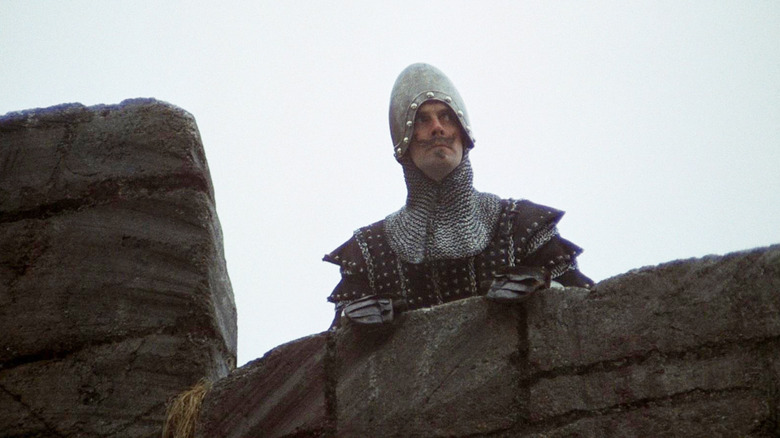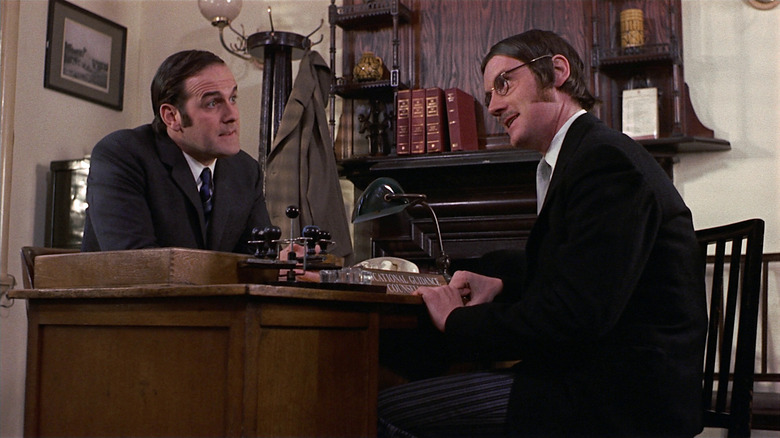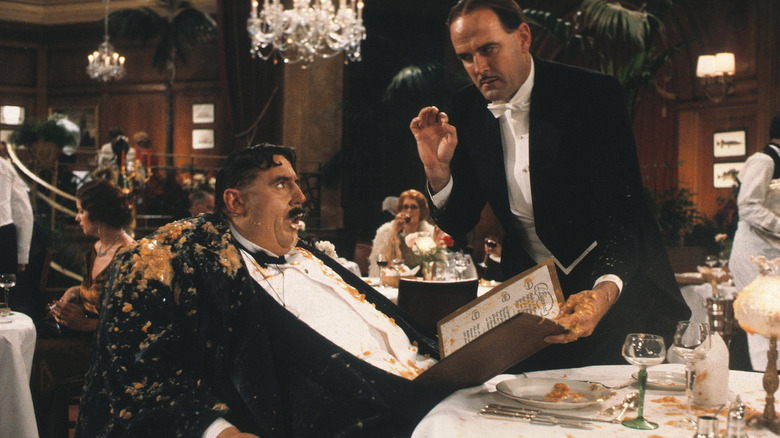The Correct Order To Watch The Monty Python Movies
I idly sit on my rocking chair, relaxing on my porch, taking in the evening breeze. There is a glass of fine rye whiskey in my hand. I am very old, and my only entertainment is a series of flashing, disconnected images in my mind. They blend together in a haze. Memories, perhaps. Or tales told to me. There is no longer a difference. I had a family once, but I cannot be certain if they were mine or something I invented. My body has been slowly shutting down, limbs feel as if they are vanishing and reappearing at their own will. Soon, I may fade out entirely.
Every so often, however, a spark appears. Like two stones striking, a light appears for a brief, explosive moment. Inside that split instant, something solid appears. Something I know is real. Something that has infiltrated the very core of my being. Something that will never vanish. I will cease to be. This spark. This spark will remain. I smile to myself and give voice to that spark, letting it live. Letting that memory stay alive in a dying world. My lips part. Air squeezes out of the ragged sacks that were once my lungs. I speak:
"Your mother was a hamster, and your father smelled of elderberries."
Terry Jones and Terry Gilliam's 1975 comedy film "Monty Python and the Holy Grail" has insidiously permeated the consciousness of an entire generation. Every line of dialogue is an invention of a new pop vocabulary that has been quoted to the point of abstraction. It's weirdly eternal. One wonders if the youths of 2023 are still watching "Monty Python's Flying Circus" reruns with the same voracity that Gen-X once did.
If not, I am here to guide The Youths™ through a journey of Monty Python. Well, the films, anyway.
The Monty Python films in release order
The five films put out by the British comedy troupe Monty Python were released in the following order:
- "And Now for Something Completely Different" (1971)
- "Monty Python and the Holy Grail" (1975)
- "Monty Python's Life of Brian" (1979)
- "Monty Python Live at the Hollywood Bowl" (1982)
- "Monty Python's The Meaning of Life" (1983)
Each one of them starred the stalwart members of the troupe: Graham Chapman, John Cleese, Eric Idle, Terry Gilliam, Terry Jones, Michael Palin, and Carol Cleveland. "And Now for Something Completely Different" is an outlier in the bunch, as it was a collection of sketches from "Monty Python's Flying Circus" re-filmed for theatrical release. The film recreated versions of "Dead Parrot," "The Lumberjack Song," "The Upper-Class Twit of the Year," and "Nudge Nudge" were not as funny as their original TV counterparts, but they were a handy way to become Python literate before their TV series began airing in the United States. That film ran on the midnight movie circuit often in the 1970s.
"The Holy Grail" is arguably their most famous film, a comedy set in the Middle Ages. "Life of Brian" is about the titular star, a man born one stable down on the same night as Jesus. "The Meaning of Life" returned to the sketch format and has songs.
"Live at the Hollywood Bowl" was culled from a quartet of live performances the troupe put on in September of 1980. It was initially intended to be a home video release but was eventually blown up to 35mm and presented briefly in U.S. theaters. It's notable as it has several sketches that weren't part of the original "Flying Circus" series, and featured segments previously only seen on "Monty Python's Fliegender Zirkus," a pair of 45-minute specials filmed for German TV in 1972.
The better order to watch the Monty Python films
The Pythons, being educated mostly in the British school system and keenly aware of history and the Classics, loved to look backward for their comedy, riffing on historical figures, and the way certain eras were depicted in popular British media. "Holy Grail" lampooned medieval Arthurian lore, while "Life of Brian" took place mostly in AD 33. Looking over their movies, one might see an opportunity to follow the Pythons through world history, chronologically. Seeing as their sketches were deliberately punchline-free, a remixing of cinematic segments may be wholly appropriate. If one wishes to watch the Python films historically, might I recommend the following, wafer-thin offering?:
Note: "MPLATHB" is "Monty Python Live at the Hollywood Bowl," "MPTMOL" is "Monty Python's The Meaning of Life," and "ANFSCD" is "And Now for Something Completely Different."
- 551 BCE – "International Philosophy" [MPLATHB]
- 0 – AD 33 – "Monty Python's Life of Brian"
- AD 932 – "Monty Python and the Holy Grail"
- 1498 – "The Last Supper" [MPLATHB]
- 1917 – "Fighting Each Other" [MPTMOL]
- 1941 – "The Battle of Pearl Harbor" [ANFSCD]
- Late 1940s – "The Funniest Joke in the World" [ANFSCD]
- 1970s – The rest of "And Now for Something Completely Different"
- 1980s – The rest of "Monty Python Live at the Hollywood Bowl"
- 1983 – The rest of "Monty Python's The Meaning of Life"
"International Philosophy" features Confucius as a character, putting it earliest in Python film canon. Heraclitus, a pre-Socratic philosopher, also appears, as does Socrates himself. That sketch, however, also features some more contemporary figures like Nietzsche, who died in 1900, and Wittgenstein, who died in 1951.
Weirdly, Monty Python has never written a sketch set in the future. And considering the still-living members of the troupe famously hate each other (which may or may not be a joke, it's not always clear), it's doubtful it'll ever happen.


